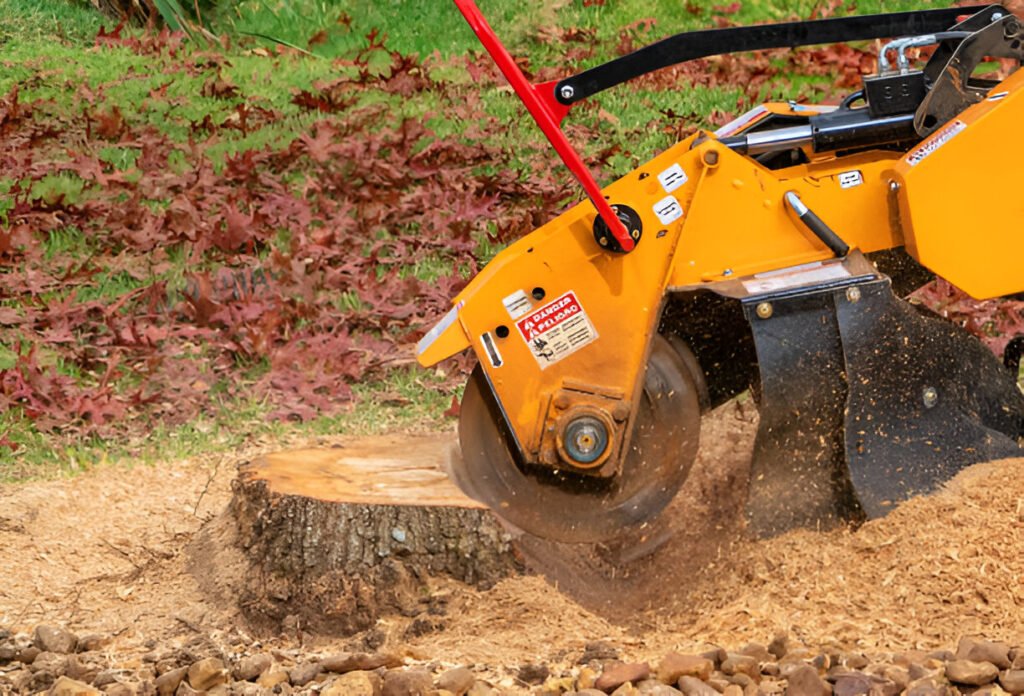If you have a tree stump in your yard and you’re considering grinding it out, you’re probably wondering how much it’ll cost here in the Bay Area. Prices vary quite a bit depending on several factors, but I’ll walk through what to expect, what influences prices, and how to make sure you get a fair deal.
What Is Stump Grinding?
Stump grinding is the process of mechanically removing a tree stump by grinding the wood into chips using a stump grinder. The goal is usually to remove the visible stump and some portion of the roots (often a few inches below ground), so you can reclaim the space for landscape, avoid tripping hazards, or prevent pests.
Typical Cost Range: General U.S., Then Bay Area
First, let’s look at what the typical cost is nationwide, so you have a benchmark.
- Most stump grinding jobs cost $140 to $450 for a single stump.
- On average, homeowners might pay around $250–$300 for a standard job.
- Some jobs could cost far less (small softwood stumps, easy access) or much more (large diameter, difficult terrain, hardwood, etc.).
In the Bay Area, because labor and operations are more expensive, you can expect the cost to be somewhat above national average in many cases. I found one localized source:
- According to TreeservicesinRedwoodCity, stump grinding in the Bay Area (Redwood City / San Francisco Peninsula) typically costs $150 – $250.
- In San Francisco, Homeyou reports stump grinding costs of about US$97 to US$134 for some medium tree stump jobs, but that seems low and likely reflects smaller stumps, possibly softer wood, easy access, or competitive bidding. It could also exclude extra fees.
- So in many Bay Area cases, a reasonable range is $150 to $300+ for a typical residential stump grinding job. Large or difficult jobs can cost more.
Key Factors that Influence the Cost
Here are the things that tend to move the price up or down. To get an accurate estimate, these are the items you should evaluate (or have the contractor evaluate).
| Factor | How It Affects Cost |
|---|---|
| Stump diameter | Probably the biggest driver. Larger stumps require more time, more machine wear, more effort. Many contractors charge by the stump’s diameter (in inches). The per‐inch rate can vary. |
| Wood type / hardness | Hardwoods (oak, maple, etc.) are tougher to grind and wear equipment more quickly, so expect extra cost. Softer woods are cheaper. |
| Accessibility / location | If the stump is easy to get to (flat yard, driveway access), cost is lower. If it’s behind a fence, in a tight corner, or on a slope, expect premiums. Also transporting equipment can cost more. |
| Number of stumps | First stump often costs more. If you have multiple stumps, additional ones are usually cheaper per stump as the crew is already on site. |
| Debris removal / cleanup | Grinding produces chips and debris. Some contractors include disposal; others charge extra. If you want the area smoothed, filled in, or re-sodded, that adds cost. |
| Permits / local regulations | Sometimes permits are required, depending on the city and whether the stump removal/grinding touches on public rights-of-way or protected vegetation. Fees & time for permits add cost. |
| Terrain / soil conditions | Rocky soil, roots tangled with structures, or ground conditions that cause more wear or slower progress will cost more. |
Bay Area Specific Considerations
Because this region is more expensive in terms of labor, equipment, permits, insurance, etc., there are a few additional local‐factors to consider:
- Labor Rates are High
Contractors in the Bay Area have higher overhead — insurance, wages, traffic time, etc. That tends to push stump grinding costs above the national norm. - Permits and Local Ordinances
Some cities have tree or stump removal ordinances, especially for street trees or for large trees. Even if it’s private property, things like neighbor complaints, regulations about watering, or preserving trees can complicate things. You might need a permit. - Access / Parking / Traffic
If equipment has to navigate narrow streets, uphill access, or limited parking, that adds time. If the stump is behind structures or fences, moving the grinder in may require extra effort (sometimes manual removal of obstructing elements). - Disposal / Waste Removal Costs
Tipping fees, disposal costs, or hauling mulch or chips away may be more costly due to Bay Area landfill or composting facility rates. - Demand Fluctuations
In certain seasons (e.g. winter storms, after heavy rains), many trees fall or are removed, increasing demand for stump grinding. Prices may surge. Off‐peak times may offer better deals.
Sample Price Scenarios for the Bay Area
Here are some hypothetical examples to give you a sense of real world pricing in the Bay Area, assuming residential yard work, typical conditions.
| Scenario | Stump Diameter | Factors | Estimated Cost* |
|---|---|---|---|
| Small hardwood stump, 6‐10 in dia, easy access, soft soil | ~8 in | Soft wood, right by driveway, no obstacles | US$100 – $200 |
| Medium stump, 12‐18 in dia, average access, moderate soil/root structure | ~15 in | Some roots, maybe near fence, must pull equipment through yard | US$200 – $300 |
| Large stump, 24‐30 in dia, hardwood, poor access (behind fence or slope), cleanup included | ~28 in | Hard wood, difficult access, removal of chips / filling hole | US$350 – $600+ |
| Multiple stumps (>2), mixed sizes, remote access, special removal or permits needed | Varied | costs increase per stump, but marginal cost per extra stump drops | US$400 – $800+ total depending on job complexity |
*These are rough estimates and will vary by city, contractor, specific job.
What You Should Ask for / Negotiate
To avoid surprises and ensure you’re getting fair value, when you get quotes from stump grinders or tree services, ask and clarify:
- What exactly is included (grinding depth below ground level, removal of chips, leveling / filling hole).
- How the pricing is calculated (flat fee, per‐inch diameter, hourly).
- Whether there’s a minimum fee or extra charges for access, difficult terrain, or hauling away debris.
- If a permit is needed in your jurisdiction, and who arranges it / pays for it.
- Who handles cleanup and restoring the site (grass, soil, sod).
- Whether insurance is covered and whether the contractor is certified/licensed.
Should You Do It Yourself?
It’s possible to rent a stump grinder or use simpler removal tools. But there are downsides:
- Rental cost can be significant (plus the time, safety gear, and risk).
- Operating heavy equipment safely takes skill. Mistakes can cost more (injury, damage to property, underground utilities).
- There may be local regulations or permit requirements even for DIY work.
Often, hiring a professional is the safer, more efficient choice — especially for larger stumps, or stumps near structures or fences.
What Is a Fair Budget for a Typical Bay Area Homeowner?
Putting all this together, for a typical single residential stump that’s medium sized (say 12–18 in diameter), good access, not extremely hard wood, and including basic cleanup, a fair budget would be around US$200 to US$350.
If you have a large stump, or special conditions (hardwood, behind fence, needing grading or filling, etc.), then budget US$400 to US$600+ or more depending on complexity.
Tips to Save Money
- Bundle jobs: If you have multiple stumps, get them done in one visit.
- Time it smart: Off-peak seasons may get you a better rate.
- Clear the path: If you can make access easy (clear obstructions, gates opened, etc.), you might save labor/time.
- Keep the chips: If mulch or wood chips are acceptable on site, avoid paying for removal.
- Get several quotes: In the Bay Area, different contractors may differ by 30-50% depending on overhead, speed, and local rates.
Conclusion
Stump grinding in the Bay Area is not cheap — you’ll likely pay more than the U.S. average. But with good estimates, clear scope, and an understanding of what drives costs, you can avoid overpaying.
If you want, I can pull up quotes or current rates for your specific city (e.g. Oakland, San Jose, Berkeley) so you know exactly what local contractors are charging. Do you want me to do that?

